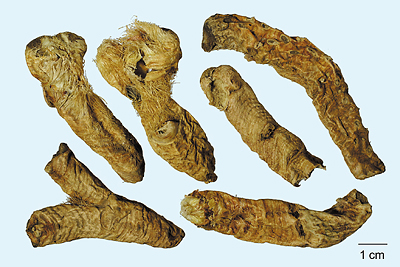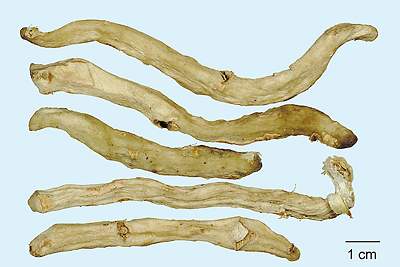Common Anemarrhena Rhizome
Common Anemarrhena Rhizome
Zhimu
知母
Source
The rhizome of Anemarrhena asphodeloides Bunge (Fam. Liliaceae).
Distribution
Mainly in Chinese provinces such as Hebei, Shanxi and Shaanxi, and in Inner Mongolia.
Harvest & Processing
Collect rhizomes in spring and autumn; remove base remnants and fibrous roots; dry rhizomes under the sun to produce ' Mao zhimu'(Hairy Common Anemarrhena Rhizome). Alternatively, peel off cork while fresh; dry rhizomes under the sun to produce 'Guang zhimu'(Glabrous Common Anemarrhena Rhizome).
Description
Mao zhimu: Rod-like, slightly curved and flat, occasionally with branches. Top end with light yellow leaf scars and stem scars; upper surface with a dented groove, and annular (ring-like) nodes arranged closely; dense yellowish-brown remnants of leaf base on nodes; underside bulgy and slightly shrivelled, marked with dented or protuberant punctiform (dot-like) root scars. Hard, breaks easily; when broken, surface yellowish-white. Taste: slightly sweet, slightly bitter; sticky when chewed. Commonly used in Hong Kong in the form of length-wise cut slices.
Guang zhimu: Outer surface white; with twisted grooves; sometimes with leaf scars and root scars.
Indications
1. Hyperpyrexia, hectic fever
2. Polydipsia
3. Cough with thick yellow sputum and difficult expectoration
4. Constipation
Chemical Composition
Mainly contains timosaponins A-I, A-II, A-III, A-IV, B-I, B-II and anemaran A, B, C, D.
Note
According to C.P., also used for medicinal purposes is the rhizome of A. chinensis (DC.) Koidz.
Photos


